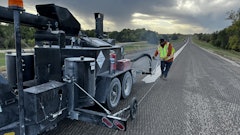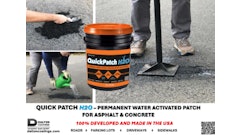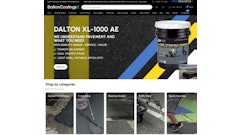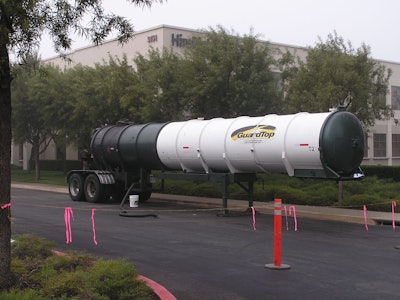
The economics of sealcoating dictate that the more sealer that can be put down in the shortest amount of time and for the least-expensive per-gallon price results in the biggest impact to a contractor’s bottom line.
So it stands to reason that contractors should do what they can to reduce the cost of the sealer they buy and shorten the length of time their crew is working on a project. One relatively easy way to combine both efforts is to use a drop tank on appropriate jobs.
Drop tanks, also called spot tanks, are 5,000-gal. tanks in which the sealer manufacturer can deliver up to about 4,000 gal. of pre-mixed or concentrated sealer right to the jobsite. Tanks are hauled to the jobsite on a semi-trailer, placed where the contractor wants them, refilled by the supplier if needed, and taken away by the supplier once the job is complete. Cost per gallon of sealer is reduced because of the volume of sealer bought and the time to and from the supplier to fill your truck is eliminated.
Drop tanks virtually eliminate downtime for crews while they’re waiting for someone to drive to the supplier or yard to pick up a load of sealer. There is additional freight cost of hauling the tank in and removing it, but that additional cost is outweighed by the lower cost of the sealer and the labor hours saved on the job.
“You can’t beat it for the convenience factor,” says Jeff Luzar, vice president of sales at Guardtop. “The convenience is second to none if the job is big enough.”
But big enough isn’t the only consideration. Yes, a job needs to be large enough to warrant a sealer manufacturer to provide and deliver a tank with material, and per-gallon material costs don’t start declining until you reach a certain threshold (different for each supplier). But the distance from the job to the supplier also is an important factor that many contractors don’t take into consideration. Even a 3,000-gal. job might warrant a drop tank if the distance from the job to the sealer supplier is too far.
“It doesn’t pay for labor to go back and forth picking up material if you can get a drop tank on the site,” Luzar says. “Even though you’re paying the freight it’s still saving you money. The break-even point is how far you have to go back and forth to get sealer.”
A contractor using 10,000 gal. of sealer a year and driving two hours round trip to fill his distributor probably doesn’t need a drop tank. But if that same contractor lands a job that requires 4,000 gal., a drop tank will enable him to complete that job more easily, more quickly, and the sealer will cost him less.
“If you need 6,000 gal. to do a project it’s more efficient to put a drop tank on the site,” says Bob Krebs, owner of SealMaster South Carolina and SealMaster North Carolina franchises. “Drop tanks allow you to put more material down faster, without having to chase after supply. And, the efficiency drops right down to your bottom line.”
Tony Heffernan, regional vice president at Neyra Industries, says contractors usually start thinking about using a drop tank at the stage in their growth where they’re doing large jobs and want to bid even larger work. “That’s when you should start considering a drop tank because then you can be competitive,” he says. “The guy who picks up sealer is not going to be competitive with the guy who buys in bulk, whether storage yard or drop tank.
“Drop tankers make you the most competitive because you’ll pay less per gallon for a drop tank and end up paying less for labor over the job,” Heffernan says. “It comes down to logistics. Guys aren’t going to want to travel to pick up sealer and they shouldn’t. So, what’s the best thing for my company and for the job?”
“If having a tanker on the jobsite reduces their cost in any way the contractor should consider it,” says Lee Lowis, vice president at GemSeal.
Plan for Drop Tank Use
Most tanks are able to hold 5,000 gal. of material, but to avoid weight regulations during transport tanks are typically delivered with no more than 4,200 gal. of material. Fees for using a tank vary, often depending on the amount a sealer a customer buys. Some manufacturers provide the tanks for free, some charge a small lease fee, others only charge the cost of delivering the tank and material to the site and picking up the empty tank from the site.
Manufacturers across the board say contractors can be more productive and more profitable by planning out any sealcoating job, regardless of size. But contractors who plan their projects can determine, first of all, if a drop tank will help them.
Considerations include how big the job is, how many gallons a crew can put down in a day, logistics of the site and how the job will be phased.
“If you’re going through 10,000 gallons on a job and you have only two days, you don’t want to be going back and forth to get all that sealer,” Luzar says. “On the other hand if the job is scheduled in a number of phases where the crew is going back to the yard each night then you probably won’t need to take on a drop tank.”
He says including suppliers in the planning process can benefit both parties. “Let the supplier know the size of the job, for example,” Luzar says. “That way he can offer some guidance on whether a drop tank might be beneficial. It also gives the supplier a heads up when a drop tank will be needed.”
Most producers have a limited number of tanks so contractors should reserve a tank as far in advance as they can. Then they should finish with them so the supplier can pick them up and turn them around quickly.
Luzar says that Guardtop, like most sealer producers, would like a notice of a week or two when a contractor will need a drop tank, but even a few days can help them out. “This is especially important in the summer when those tanks are going out at a fast and furious pace,” Luzar says. “As fast as we’re getting those tanks in we’re sending them out again.”
Bill Maclean, The Brewer Co., says holiday weekends are a busy time for drop tankers. “That’s something to think about because more people are competing for a limited number of tanks during those periods,” Maclean says. “You usually schedule those jobs well ahead -- it's easy to reserve a drop tanker at the same time."
Just as it’s important to reserve a tank, it’s equally important to let the supplier know in advance when you’re going to need a refill. Luzar says that the more advance notice a contractor can give, then easier and more smoothly the resupply is going to go for both parties.
“If they know in advance they’re going to need a boost, let us know that when you place the order and let us know which day you’ll need it. We’ll have it there for you,” Luzar says.
“Also let the supplier know as soon as the tank can be picked up,” Luzar says. “If the job is done in one day or two days just let us know and we’ll come and get it. Those tanks are always in demand, so anytime we can get one back that’s a big help.”
“Plan, plan, plan,” Krebs says. “One of our biggest challenges is to get the contractors to estimate well in advance. When will they need it? When will they need a refill? When can we pick it up?
“If they don’t plan ahead it’s possible we won’t have a tank when they need it and, if we do, it’s possible the contractor’s crew will be sitting idle waiting for a refill delivery that wasn’t scheduled. We don’t want to see that happen.”
Accepting Drop Tank Delivery
Most manufacturers prefer the contractor be on site to accept delivery, though in some cases contractors can send a property map with an X marking the tank location.
“The contractor decides where the unit is spotted.” Lowis says. “They should always meet the delivery driver because occasionally the tankers cannot be left where the contractor would like it to be.”
“Having the contractor there can help prevent some issues that might not have been considered when the X was put on the map,” Luzar says.
Heffernan says that Neyra will ask for a map of the property as well ask for the contractor’s plan to sealcoat it. “That helps use determine how long the tank will be needed and if and when we’ll have to bring more sealer,” he says.
Maclean says The Brewer Co. prefers the contractor to be on site when the drop tank is delivered. “We don’t want to have to come back to move the tanker,” Maclean says.
Another reason to be on site when the tank is delivered is in case the property owner or manager wants to change where you plan to locate the tank. Manufacturers say contractors should let the property manager know where the tank will be placed, and if they balk just explain why it needs to be where you want it.
“Inform the property owner of the realities of equipment limitations,” Maclean says. “They don’t understand that it can take a nose dive and spill sealer all across their lot or lawn if it’s not placed properly.”
“A lot of time it’s a negotiation between the property owner and the contractor, but we need to get in there with an 18-wheeler, we need to be able to get in there to maneuver the tank, and depending on the job we might need to get back in there to refill it,” Krebs says.
Determining Drop Tank Location
As a general rule, place the tank in a corner of the parking lot, away from everything. When sealcoating in a homeowner’s association, keep the tank away from any main thoroughfares, don’t put it in front of anyone’s house, and keep it away from where children will play.
“Always consider safety first,” Lowis says.
Then think about normal traffic flow through the jobsite, including access to deliveries. “Make sure that you consider all of the time that the tanker is on site, not just the hours and days that the job is performed,” Lowis says.
He says don’t block access to deliveries, and don’t place the tank in an area that might block the supplier from picking it up when you’re done. “For example, can someone park too close to the tanker after the contractor removes their barricades?”
“Most of the time it’s placed where we least inconvenience their customers or, in the case of a homeowner’s association, the people who live there,” Krebs says. “Some properties have a very tight ingress and egress. Contractors should be aware that flower beds and grass could be damaged by the 80,000 pound 18-wheelers trying to position the drop tank into your desired location. In this case, it may be better to identify a spot for the drop tank away from the property you are sealing.”
“You want it out of the way so if something happens – a line blows or there’s a sealer spill – it’s not a problem for anyone but the contractor,” Heffernan says.
But there’s more to determining location than that. Factors include:
- Easy supplier access to drop off and pick up the tanker
- Easy supplier access to refill with additional loads of sealer if needed
- Public traffic
- Service and delivery vehicles
- Ease of off-loading into sealer application equipment
- Tank controls should be open to the parking lot
- Never place the tank on dirt or grass
“First, the site needs to be accessible by a semi-truck,” Maclean says. “It might be easy for a car or pickup to get in there but you’re dealing with a semi to deliver it and deliver additional sealer if the job requires it.”
Maclean says the tank has to be parked in an area strong enough to support the weight of the tank and material, otherwise the landing gear will punch through the pavement. He estimated tractor, trailer and material weigh roughly 80,000 lbs. (50,000-60,000 lbs. empty). Some manufacturers modify the tankers, placing a steel plate beneath the landing gear to spread the weight out. If your supplier doesn’t provide that you can place additional blocks beneath the trolley wheels to disperse the weight.
He says the best location is a concrete pad because not only will the concrete support the tank weight, you won’t have to move the tank to seal beneath it.
“If you have to place it on asphalt that needs to be sealed then consider sealing it in advance of the tank,” Maclean says. “But if you do place it on concrete be especially careful of spills.”
Manufacturers all say to locate the tank so it won’t have to be moved as you progress through the sealcoating job. If it has to be on asphalt that needs sealing, either seal the area before the tank is placed or seal it after the tank is removed.
“Think ahead because you don’t want to have it situated where we can’t get to it to move it because you’ve started striping the parking lot,” Luzar says.
“You want to move it only once if possible,” Krebs says. “That’s when we take it out.”







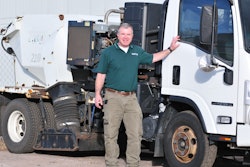




![Lee Boy Facility 2025 17 Use[16]](https://img.forconstructionpros.com/mindful/acbm/workspaces/default/uploads/2025/09/leeboy-facility-2025-17-use16.AbONDzEzbV.jpg?ar=16%3A9&auto=format%2Ccompress&fit=crop&h=135&q=70&w=240)

